
The Khanate of Sibir was a Muslim state located just east of the middle Ural Mountains. Its conquest by Yermak Timofeyevich in 1582 was the first event in the Russian conquest of Siberia.

The Khanate of Sibir was a Muslim state located just east of the middle Ural Mountains. Its conquest by Yermak Timofeyevich in 1582 was the first event in the Russian conquest of Siberia.
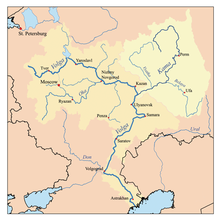
The republic of Novgorod developed a fur-trading empire across northern Russia as far as the northern Urals and somewhat beyond. East of Novgorod the land was gradually falling under the control of Moscow. Between Moscow and the Urals was the Khanate of Kazan which broke off from the Golden Horde about 1438. In 1478 Moscow captured Novgorod and in 1552, Kazan. This opened up the Perm and Kama River area northeast of Kazan. In 1558 the Stroganovs were given a large fief in the area and began to develop it. There was scattered native resistance. In 1573 the Khan of Sibir sent his nephew to raid the Stroganov lands. Moscow responded with a charter that effectively authorized the Stroganovs to launch a private war against the Khan, but this was not acted on.

The middle Urals at the latitude of Perm are fairly low and easy to cross. The area was inhabited by the Voguls (Mansi) and, north of Tobolsk, the Ostyaks (Khanty people). At some date a group of Siberian Tatars established the Khanate of Sibir and formed a military ruling class over a non-Muslim population. These 'Tatars' were partly Turko-Mongol Muslims from further south and partly local converts to Islam. Two clans contended for power. The Shaybanids were descendants of Genghis Khan. The Taibugids were probably of local origin. In 1563 Kuchum, a Shaybanid, defeated his Taibugid opponent and seized the throne. Before 1571 the Khanate paid limited tribute to Moscow.
The Siberian Chronicles are incomplete and contradictory as are the secondary sources in English. This account follows Lantzeff [1] which seems to be the fullest account in English. Lantzeff follows S. V. Bakhruskin. The main problems are the year the expedition started, details of the route, and the location of the battle at Sibir.
Ermak began his career as a river pirate somewhere on the Volga. In about 1577, the pirates were dispersed by Muscovy. Ermak arrived at Perm sometime later (possibly 1579 [2] ). His purpose in invading Siberia is not clear. It seems to have been a sort of reconnaissance in force that evolved into a conquest when the Khanate proved weak. It is not clear whether Ermak went on his own initiative, whether he was sent by the Stroganovs, or the Stroganovs encouraged him to go to get rid of a dangerous body of armed men. Ermak had 540 Cossacks. The Stroganovs provided most of the supplies and another 300 men, mostly so-called 'Litva', or prisoners-of-war held by the Stroganovs.
Ermak left Perm probably in the summer of 1581. (Fisher [3] has him start in September 1579 and take Sibir in October 1581. Lincoln [4] has Ermak leave on September 1, 1582 and conquer Sibir three months later. Naumov says that late twentieth century historians established 1582 as the starting date, but this leaves little time for boat-building on the Tura if Sibir was captured in 1582, a date which Naumov accepts.) He sailed south down the Chusovaya River. When the river grew shallow and the weather turned cold he built winter quarters in the mountains. Here he raided the local Mansi, news of which provoked native opposition later on. In the spring he crossed the Urals to the Barancha River (according to Lantzeff, but the Barancha is somewhat north of the latitude of Perm). He built rafts, sailed down the river, and converted the rafts to boats when the river grew deep enough. Entering the Tura River he sailed downstream (southeast) and defeated a native prince named Epancha at the later site of Turinsk. (Naumov has Ivan Koltso and 300 men, probably Stroganov's 300, join Ermak at this point, but other sources do not mention this). Continuing down the Tura, he captured Tyumen (according to the Remizov chronicle, but Bakhruskin thinks that the fort here had been abandoned). On reaching the Tobol River they defeated a native force, sailed downstream (north) and later won two other battles before reaching the mouth of the Tavda River. Twenty miles below the Tavda they fought another battle and then captured a native village where they rested for a month. (this delay so close to the enemy, if it happened, seems very strange.)
Leaving camp, they sailed 12 miles [5] down the Tobol to its junction with the Irtysh River at the modern Tobolsk. 12 miles east up the Irtysh was Sibir. The Russians captured the village of Atik-Murza for a base and unsuccessfully attacked Sibir. Several days later they attacked again. The commander, Mamet-Kul, was wounded which led to disorganization. The Ostyaks broke first, and then the Voguls, leaving only the Tatars. Kuchum fled during the night and the Russians entered his capital the next morning. This was probably in October 1582. The Russians had lost 107 men. {Battle of Chuvash Cape gives a slightly different account. Grousset [6] has the battle at 'a fortified camp at the mouth of the Tobol to protect the approaches to Sibir'. Naumov has it 'not far from Sibir'. A fort may have guarded the town further upriver, but the matter is not clear.}
Over the next several months various native chieftains offered their submission. Ermak, perhaps unexpectedly, found himself the ruler of a Khanate and sent Ivan Koltso, 50 men, and 5,200 furs to Moscow to announce his conquest. Meanwhile, the Ostyaks and Voguls had been raiding the Perm territories. Ivan the Terrible thought that Ermak had provoked that and sent an angry letter to the Stroganovs that demanded Ermak's recall to protect Perm. A few days later, Ermak's envoys reached Moscow. The Tsar immediately changed his mind and promised to send a Voyevoda and troops. He sent Ermak gifts, including the famous suit of armor.
The Cossacks sent out raiding parties to collect Yasak. Bogdan Bryazga went north down the Irtysh as far as its junction with the Ob. Ermak explored the Tavda.
Kuchum's whereabouts at the time is uncertain. His nephew, Mamet-Kul, attacked the Russians several times, but was captured on the Vagai River and sent to Moscow, where he later had an honorable career under the name Sibirsky. Seid Akhmat, Kuchum's Taibugid rival, returned to the area and gained some supporters. 'The Karacha' (one of Kuchum's former officials) sent a request to Ermak for help in fighting the steppe nomads. When the forty Cossacks under Ivan Koltso arrived, they were murdered. A punitive expedition was defeated, which seems to have set off a general uprising and it became unsafe to leave the fort at Sibir. About this time (November 1584) 500 reinforcements, including Streltsy, arrived from Russia. Food was inadequate and there were many deaths over the winter. In March the Karacha besieged Sibir. Two months later, it was broken by a sortie (Naumov has the sortie in March).
In August 1585, Ermak heard that a caravan was arriving from the south and that Kuchum was waiting to plunder it. He went up the Irtysh to capture either the caravan or Kuchum but found that there was no caravan. Returning, he camped at the mouth of the Vagai River about 25 miles upstream from Tobolsk. The night was stormy and the watch inadequate. Kuchum's men attacked and most of the Russians were killed in their sleep. The story, which may be true, is that Ermak tried to flee to a river boat and was drowned by the weight of the armor that the Tsar had sent him.
Command passed to Ivan Glukhov. With only 150 surviving men, he thought it was impossible to hold out and so he sailed down the Irtysh and Ob and crossed into Russia over the northern Urals. Ali, Kuchum's son, reoccupied the town.but was driven out by Seid Akhmat (Naumov calls him Seidiak).
Reinforcements under Mansurov arrived but were not strong enough to do anything. They wintered somewhere on the Ob and crossed the Urals the following spring, in 1586 (Naumov has Glukhov and Mansurov meeting and returning to Russia together).
Ermak had failed, but the Khanate of Sibir had been broken up, and Seid Akhmat could not restore it. The area was left to native chiefs, who had few firearms. The Russians' policy was based on systematic fort-building and were using that method to expand south of Moscow. In 1586, three hundred Russians built an Ostrog (fortress) at Tyumen, and in 1587, they built another fort at Tobolsk. In 1588, Seid Akhmat and the Karacha were invited to Tobolsk, captured, and sent to Moscow.
In 1594, Tara was built on the middle Irtysh to guard the caravan route. In 1591, the Konda River Mansi were annexed. In 1594 Surgut, at the junction of the Ob and the Irtysh was founded. That year, the Prince of Pelym was defeated.
Kuchum made a number of attacks but was defeated on the Barabinsk Steppe, probably in 1598. That year, Verkhoturye was built to secure the route over the Urals. In the 1590s, the Russians crossed the northern Urals into the lower Ob basin. Ketsk was founded in 1602, opening the route to the Yenisei River. For the rest, see Siberian River Routes and History of Siberia.

The Ural Mountains, or simply the Urals, are a mountain range in Eurasia that runs north-south mostly through Russia, from the coast of the Arctic Ocean to the river Ural and northwestern Kazakhstan. The mountain range forms part of the conventional boundary between the continents of Europe and Asia. Vaygach Island and the islands of Novaya Zemlya form a further continuation of the chain to the north into the Arctic Ocean. The average altitudes of the Urals are around 1,000–1,300 metres (3,300–4,300 ft), the highest point being Mount Narodnaya, which reaches a height of 1,894 metres (6,214 ft).
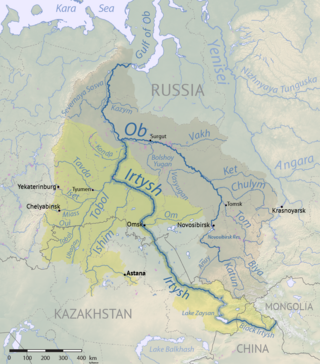
The Irtysh is a river in Russia, China, and Kazakhstan. It is the chief tributary of the Ob and is also the longest tributary river in the world.

The Khanate of Sibir (Siberian Tatar: Сыбыр ҡанныҡ, Искәр йорт; Russian: Сибирское царство, Сибирский юрт) was a Siberian Tatar Khanate in western Siberia, founded at the end of the 15th century, following the break-up of the Golden Horde. Throughout its history, members of the Shaybanid and Taibugid dynasties often contested the rulership over the Khanate between each other; both of these competing tribes were direct patrilineal descendants of Genghis Khan through his eldest son Jochi and Jochi's fifth son Shayban (Shiban). The area of the Khanate had once formed an integral part of the Mongol Empire, and later came under the control of the White Horde and the Golden Horde of 1242–1502.

The early history of Siberia was greatly influenced by the sophisticated nomadic civilizations of the Scythians (Pazyryk) on the west of the Ural Mountains and Xiongnu (Noin-Ula) on the east of the Urals, both flourishing before the common era. The steppes of Siberia were occupied by a succession of nomadic peoples, including the Khitan people, various Turkic peoples, and the Mongol Empire. In the Late Middle Ages, Tibetan Buddhism spread into the areas south of Lake Baikal.

Tobolsk is a town in Tyumen Oblast, Russia, located at the confluence of the Tobol and Irtysh rivers. Founded in 1590, Tobolsk is the second-oldest Russian settlement east of the Ural Mountains in Asian Russia, and was the historic capital of the Siberia region. Population: 100,352 (2021 Census); 99,694 (2010 Census); 92,880 (2002 Census); 94,143 (1989 Census).

The Tobol is a river in Western Siberia and the main (left) tributary of the Irtysh. Its length is 1,591 km (989 mi), and the area of its drainage basin is 426,000 km2 (164,000 sq mi).
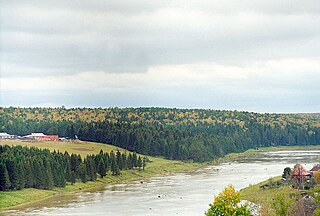
The Tura, also known as Dolgaya is a historically important Siberian river which flows eastward from the central Ural Mountains into the Tobol, a part of the Ob basin. The main town on it is Tyumen.

Yermak Timofeyevich was a Cossack ataman and is today a hero in Russian folklore and myths. During the reign of the Russian tsar Ivan the Terrible, Yermak started the Russian conquest of Siberia.
Kuchum Khan was the last Khan of Siberia who ruled from 1563 to 1598.

The Chulyms, also Chulym Tatars, are a Turkic people in the Tomsk Oblast and Krasnoyarsk Krai in Russia. According to the 2020 census, there were 382 Chulyms in Russia.

Qashliq, Isker or Sibir was a medieval Siberian Tatar fortress, in the 16th century the capital of the Khanate of Sibir, located on the right bank of the Irtysh River at its confluence with the Sibirka rivulet, some 17 km from the modern city of Tobolsk. The fortress is first mentioned in Russian sources of the 14th century.

The Tavda is a Siberian river that drains part of the central Ural mountains into the Tobol. It is north of the Tura and south of the Konda. It is located in Sverdlovsk Oblast and Tyumen Oblast.

The Battle of Chuvash Cape led to the victory of a Russian expedition under Yermak Timofeyevich and the fall of Khanate of Sibir and the end of Khan Kuchum's power. The battle took place near Qashliq (Isker).

The Russian conquest of Siberia took place during 1580–1778, when the Khanate of Sibir became a loose political structure of vassalages that were being undermined by the activities of Russian explorers. Although outnumbered, the Russians pressured the various family-based tribes into changing their loyalties and establishing distant forts from which they conducted raids. It is traditionally considered that Yermak Timofeyevich's campaign against the Siberian Khanate began in 1580. The annexation of Siberia and the Far East to Russia was resisted by local residents and took place against the backdrop of fierce battles between the Indigenous peoples of Siberia and the Russian Cossacks, who often committed atrocities against Indigenous Siberians.
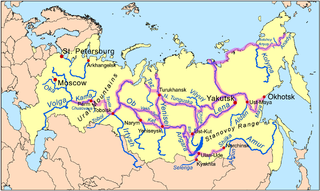
Siberian River Routes were the main ways of communication in Russian Siberia before the 1730s, when roads began to be built. The rivers were also of primary importance in the process of Russian conquest and exploration of vast Siberian territories eastwards. Since the three great Siberian rivers, the Ob, the Yenisey, and the Lena all flow into the Arctic Ocean, the aim was to find parts or branches of these rivers that flow approximately east-west and find short portages between them. Since Siberia is relatively flat, portages were usually short. Despite resistance from the Siberian tribes, Russian Cossacks were able to expand from the Urals to the Pacific in only 57 years (1582-1639). These river routes were crucial in the first years of the Siberian fur trade as the furs were easier to transport over water than land. The rivers connected the major fur gathering centers and provided for relatively quick transport between them.
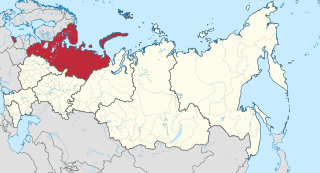
Northwest Russia, or the Russian North is the northern part of western Russia. It is bounded by Norway, Finland, the Arctic Ocean, the Ural Mountains and the east-flowing part of the Volga. The area is roughly coterminous with the Northwestern Federal District, which it is administered as part of. Historically, it was the area of the Novgorod and Pskov merchant republics.

The Ural Oblast was an oblast of the RSFSR within the USSR. It was created November 3, 1923 by the merger of Perm, Yekaterinburg, Chelyabinsk and Tyumen Governorates. The capital of the oblast was Sverdlovsk. At the time of its creation area of oblast was 1,659,000 km2 and the population was 6,380,000.

The Principality of Kod, or the Principality of Koda (Кода), was a Khanty principality located in north Western Siberia from the 15th to 17th century. It was located on both banks of the Ob River and along the river tributaries of Kazym and Irtysh, occupying an area approximately now the Oktyabrsky District of the Khanty-Mansi Autonomous Okrug. The rulers of Kod, the House of Alachev, had in their possession various fortified towns along the banks of the Ob, the largest of which being the capital of Shorkar, later Alachev. Kod was generally allies of the Grand Duchy of Moscow, and later the Tsardom of Russia, engaging in conflicts with other Yugra states like the Principality of Pelym, though occasionally also siding with enemies of Moscow, like Kuchum Khan of the Sibir Khanate or rebel Ivan Bolotnikov. The principality was ultimately annexed into the expanding Russian state in 1643.